After the initial launch and log in, Voice is configured by default to launch and log in automatically when you start your computer, but you can also launch it from the desktop shortcut.
- Double-click the nVoq Voice desktop shortcut to launch the application.

- By default, Voice is configured to automatically log in with the previously entered system, username, and password. However, if that setting is disabled or if you signed out of Voice...
- Select the system on which your dictation account exists, or keep the default setting (healthcare.nvoq.com).
- If your account is on the Canada system, click on the field and select the Canada system instead.
- If you need to use a system that is not listed, type the system URL (e.g. test.nvoq.com) into the field. Voice will remember the system you enter, so you won't need to type in again. Click your mouse onto the white space outside of the system menu to close the menu.
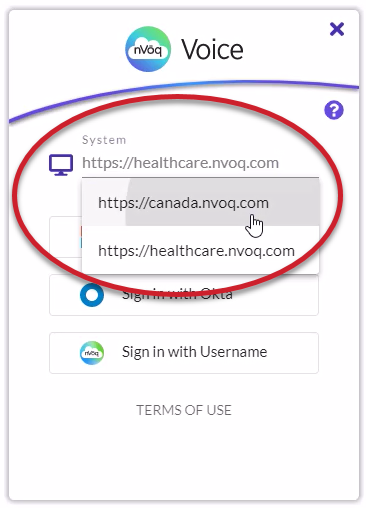
- Select how you want to sign in:
- To log in with a Microsoft SSO account, click Sign in with Microsoft.
- To log in with an Okta SSO account, click Sign in with Okta.
- To log in with an nVoq Account, click Sign in with Username.
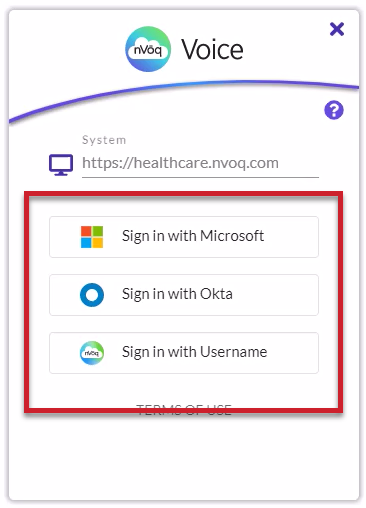
No matter which way you sign in, Voice will remember your system, username, and new password by default and automatically log you in the next time you launch it.
In the event that Voice cannot connect to the system selected, a red message will appear the top of the sign in screen that says, "Could not connect to server.
- Select the system on which your dictation account exists, or keep the default setting (healthcare.nvoq.com).
Sign in with Microsoft
- Enter your Microsoft account username and click the Next button.
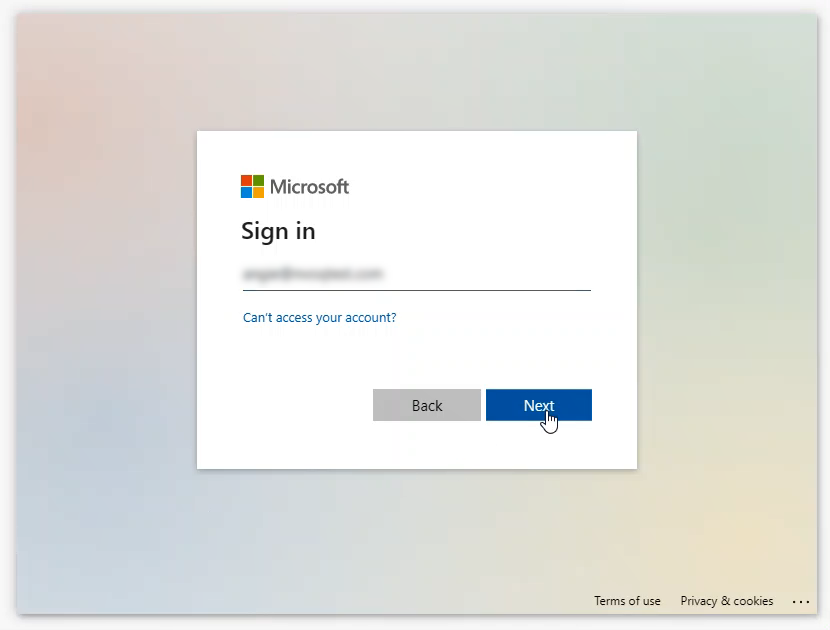
- Enter your Microsoft SSO password, then click the Sign In button.

- After you sign in, the dictation button will appear and pulsate for a couple of seconds to let you know the app is running.

Poor Microphone Detected
If a built-in or "array" microphone is configured for nVoq Voice, a message stating, "Poor Microphone Detected". will appear after you sign in. Using an array or built-in microphone on your computer could affect your recording quality and impact dictation transcript accuracy. If you have a better microphone connected to your computer that nVoq Voice did not automatically start using, go to the Settings (click the gear icon next to the dictation button) and select it from the Microphone menu. See: Settings: Microphone
You can use your Android or iOS device for a microphone.
To use your Android or iOS device as a microphone you will need to install the nVoq Wireless Microphone app on your device and sign in to the app with your nVoq account (which has the same username as your Microsoft account). The Wireless Microphone will connect to Voice as long as you sign in with the same username on the same system. Click HERE to watch a video!
You can use your Android or iOS device for a microphone.
To use your Android or iOS device as a microphone you will need to install the nVoq Wireless Microphone app on your device and sign in to the app with your nVoq account (which has the same username as your Microsoft account). The Wireless Microphone will connect to Voice as long as you sign in with the same username on the same system. Click HERE to watch a video!
It may take two (2) attempts to sign back in to a Microsoft account after signing out.
After signing out of Microsoft from Voice, the next time you sign back in to Voice with your Microsoft account you may receive an "Invalid user name and/or password" message from Voice even though you entered the correct username and password. When you tap the Sign in with Microsoft button again on the Voice sign in screen, you are immediately logged in to your account.
Sign In with Okta
- Enter your Company ID and click the SIGN IN button. This will be saved for you the next time you sign in.
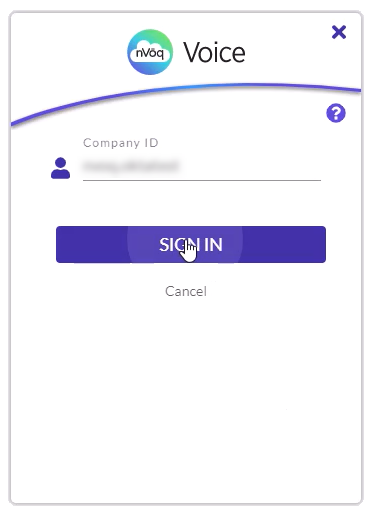
- Enter your OKTA username and password and then click the Sign In button.
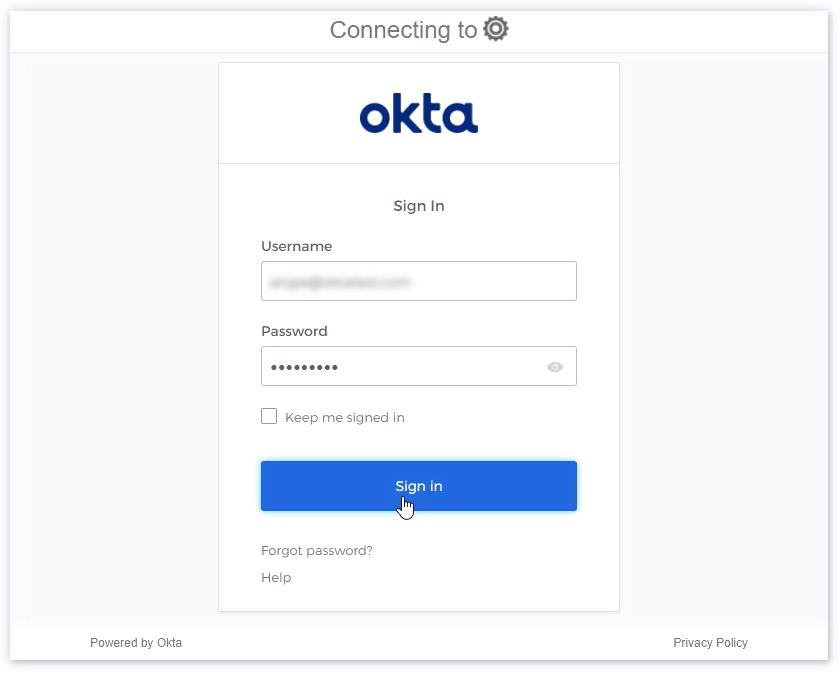
- After you sign in, the dictation button will appear and pulsate for a couple of seconds to let you know the app is running.

Poor Microphone Detected
If a built-in or "array" microphone is configured for nVoq Voice, a message stating, "Poor Microphone Detected". will appear after you sign in. Using an array or built-in microphone on your computer could affect your recording quality and impact dictation transcript accuracy. If you have a better microphone connected to your computer that nVoq Voice did not automatically start using, go to the Settings (click the gear icon next to the dictation button) and select it from the Microphone menu. See: Settings: Microphone
You can use your Android or iOS device for a microphone.
To use your Android or iOS device as a microphone you will need to install the nVoq Wireless Microphone app on your device and sign in to the app with your nVoq account (which has the same username as your Okta account). The Wireless Microphone will connect to Voice as long as you sign in with the same username on the same system. Click HERE to watch a video!
You can use your Android or iOS device for a microphone.
To use your Android or iOS device as a microphone you will need to install the nVoq Wireless Microphone app on your device and sign in to the app with your nVoq account (which has the same username as your Okta account). The Wireless Microphone will connect to Voice as long as you sign in with the same username on the same system. Click HERE to watch a video!
Sign in with Username (nVoq Account)
- Enter your nVoq username and password and click the Sign In button.
- Optionally click the eye icon to the right of the Password field to see the password you entered.
- If you don't know your nVoq username or password, click the Forgot Password link below the password field. See Forgot nVoq Username or Password.

- If you enter an incorrect password too many* times, your account may be temporarily locked for 15 minutes. You can either wait 15 minutes and try again with the same password, or reset your password for immediate access.
*The number of times you can enter an incorrect password before your account is locked is a setting (Maximum Failure) configured at the division level for your organization. If your account has an Administrator Role, the Maximum Failure is automatically set to 5. - If your nVoq account is not configured to use dictation (e.g. a shortcut-only account or an admin-only account), an error message that says your account is "forbidden" will display.
- If you enter an incorrect password too many* times, your account may be temporarily locked for 15 minutes. You can either wait 15 minutes and try again with the same password, or reset your password for immediate access.
- If this is your first time signing in you may be taken to a screen that requires you to change your password.
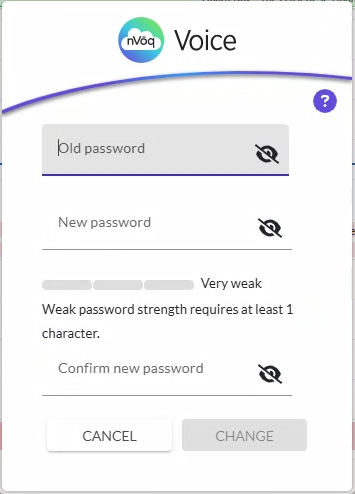
- After you sign in, the dictation button will appear and pulsate for a couple of seconds to let you know the app is running.

Poor Microphone Detected
If a built-in or "array" microphone is configured for nVoq Voice, a message stating, "Poor Microphone Detected". will appear after you sign in. Using an array or built-in microphone on your computer could affect your recording quality and impact dictation transcript accuracy. If you have a better microphone connected to your computer that nVoq Voice did not automatically start using, go to the Settings (click the gear icon next to the dictation button) and select it from the Microphone menu. See: Settings: Microphone
You can use your Android or iOS device for a microphone.
To use your Android or iOS device as a microphone you will need to install the nVoq Wireless Microphone app on your device and sign in to the app with your nVoq account. The Wireless Microphone will connect to Voice as long as you sign in with the same username on the same system.
You can use your Android or iOS device for a microphone.
To use your Android or iOS device as a microphone you will need to install the nVoq Wireless Microphone app on your device and sign in to the app with your nVoq account. The Wireless Microphone will connect to Voice as long as you sign in with the same username on the same system.